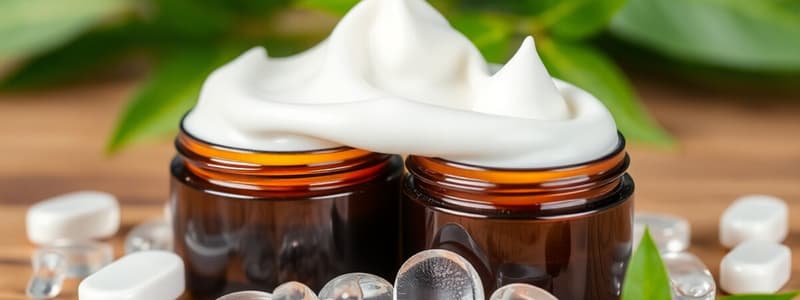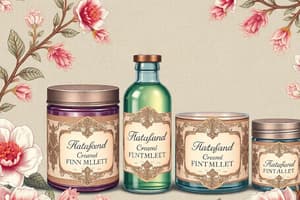Podcast
Questions and Answers
What is a key characteristic of creams that makes them susceptible to microbial growth?
What is a key characteristic of creams that makes them susceptible to microbial growth?
- Emulsification
- Presence of water (correct)
- Low pH
- High viscosity
Which type of cream is known for its ability to promote prolonged contact at the site of application?
Which type of cream is known for its ability to promote prolonged contact at the site of application?
- Lotions
- Ointments
- Creams (correct)
- Gels
What is a disadvantage of using creams compared to ointments?
What is a disadvantage of using creams compared to ointments?
- More washable
- Higher risk of contamination (correct)
- Less irritating to the skin
- Faster drying on application
What is another name for oil-in-water (o/w) creams?
What is another name for oil-in-water (o/w) creams?
Which emulsifying agents are commonly used to produce water-in-oil (w/o) creams?
Which emulsifying agents are commonly used to produce water-in-oil (w/o) creams?
What is a characteristic of O/W creams according to the miscibility test?
What is a characteristic of O/W creams according to the miscibility test?
Which of the following oils is NOT mentioned as a source for vegetable oils?
Which of the following oils is NOT mentioned as a source for vegetable oils?
What type of cream is described as providing good emollient properties but is not readily washable by water?
What type of cream is described as providing good emollient properties but is not readily washable by water?
Which type of oil is primarily described as chemically inert and occlusive?
Which type of oil is primarily described as chemically inert and occlusive?
What is true about the droplets of O/W emulsions when observed under UV radiation?
What is true about the droplets of O/W emulsions when observed under UV radiation?
Which of the following statements regarding mineral oils is correct?
Which of the following statements regarding mineral oils is correct?
What type of cream typically has a continuous phase that fluoresces?
What type of cream typically has a continuous phase that fluoresces?
In which test do O/W creams demonstrate their electrical conduction properties?
In which test do O/W creams demonstrate their electrical conduction properties?
Why is it necessary to always make an excess when compounding creams?
Why is it necessary to always make an excess when compounding creams?
What is the recommended extra amount to prepare when compounding cream?
What is the recommended extra amount to prepare when compounding cream?
What should be checked before preparing the fatty base for cream compounding?
What should be checked before preparing the fatty base for cream compounding?
At what temperature should the fatty base be cooled before mixing other ingredients?
At what temperature should the fatty base be cooled before mixing other ingredients?
Why might the temperature of the aqueous phase be adjusted to a few degrees higher than the oily phase?
Why might the temperature of the aqueous phase be adjusted to a few degrees higher than the oily phase?
What is the concentration range for Butylated Hydroxyanisole as an antioxidant?
What is the concentration range for Butylated Hydroxyanisole as an antioxidant?
Which of the following is NOT a recommended humectant for creams?
Which of the following is NOT a recommended humectant for creams?
What is the primary purpose of levigation in cream compounding?
What is the primary purpose of levigation in cream compounding?
At what temperature range is mixing by fusion typically performed when making ointments?
At what temperature range is mixing by fusion typically performed when making ointments?
Which term refers to the process of grinding powders to mix them into a base?
Which term refers to the process of grinding powders to mix them into a base?
What is the maximum recommended concentration of sodium metabisulphite as an antioxidant?
What is the maximum recommended concentration of sodium metabisulphite as an antioxidant?
Why is hygiene emphasized in the process of compounding creams?
Why is hygiene emphasized in the process of compounding creams?
Which of the following is involved in the 'doubling up' technique during trituration?
Which of the following is involved in the 'doubling up' technique during trituration?
What is the appropriate temperature to add the disperse phase when making creams?
What is the appropriate temperature to add the disperse phase when making creams?
How should the emulsion be stirred during the preparation of the cream?
How should the emulsion be stirred during the preparation of the cream?
What can be a consequence of hastening the cooling process during cream preparation?
What can be a consequence of hastening the cooling process during cream preparation?
What is the primary role of the cetrimide in the Dimethicone cream formulation?
What is the primary role of the cetrimide in the Dimethicone cream formulation?
What is the total weight of the oily phase in the Dimethicone cream formula?
What is the total weight of the oily phase in the Dimethicone cream formula?
What type of cream is being prepared according to the master formula provided?
What type of cream is being prepared according to the master formula provided?
Which ingredient in the formulation serves as a thickening agent?
Which ingredient in the formulation serves as a thickening agent?
What should one avoid while stirring the emulsion during cream preparation?
What should one avoid while stirring the emulsion during cream preparation?
Flashcards are hidden until you start studying
Study Notes
Creams
- Viscous semisolid emulsions for external use only
- Susceptible to microbial growth due to the presence of water
- Consists of medicaments which can be dissolved or suspended in either oil-in-water or water-in-oil cream base
Advantages of Creams
- Prolonged contact at the application site
- Non-sticky and easily washable
- Non-irritating on application to the skin
- Dry the injured area more quickly than ointment
Disadvantages of Creams
- Less hydrophobic, hence higher risk of contamination
Oil-in-water (o/w) Creams
- Also known as aqueous cream or vanishing cream
- Produced by synthetic waxes (e.g. macrogol, cetomacrogol)
- Thin, white, and smooth in consistency
- Water washable base for rapid absorption and penetration of drugs
- Examples: aqueous cream, cosmetic creams
Water-in-oil (w/o) Creams
- Also known as oily cream
- Produced by natural emulsifiers (e.g. beeswax, wool fat or wool alcohols)
- Creamy, white or translucent, and rather stiff
- Provide good emollient properties; not readily washable by water; gives a cooling sensation
- Examples: Cold cream
Distinguishing between O/W and W/O Cream
- Miscibility Test: O/W creams are miscible with water, while W/O creams are miscible with oil
- Microscopic Examination: O/W creams have colored droplets after staining with an oil-soluble dye, while W/O have colored backgrounds
- Microscopic Observation under UV radiation: O/W creams have droplets that fluoresce, while W/O creams have continuous phases that fluoresce
- Conductivity Measurement: O/W creams are conductors of electricity, while W/O creams are poor conductors
Oily Vehicles
- Mineral oils (paraffins): most widely used, complex mixtures of saturated hydrocarbons; occlusive; chemically inert; do not give good skin penetration
- Vegetable oils: plant sources (e.g. peanut, castor, olive and coconut); occlusive; give good skin penetration
- Synthetic oils
Mineral Oils (Paraffins)
- Commonly used types include soft paraffins, liquid paraffins, and hard paraffins
- White soft paraffin and yellow soft paraffin are used to thin or thicken products
- The choice of paraffin depends on the colors of the ingredients
Vegetable Oils
- Oxidation can be controlled by adding antioxidants such as:
- Butylated hydroxyanisole (0.02~0.5% w/w)
- Butylated hydroxytoluene (0.02~0.5% w/w)
- Sodium metabisulphite (0.01~1% w/v)
- Sodium sulphite (0.1% w/v)
Humectants
- Hydroscopic materials added to decrease water loss from creams
- Used at concentrations of 5 - 15%
- Examples: Glycerol (glycerin), Propylene glycol, Polyethylene glycol 300
Compounding Creams: Terminologies
- Mixing by Fusion: Melting together the fatty bases over a water bath before incorporating other ingredients
- Trituration: Incorporation into the base of finely divided insoluble powders or liquids
- Levigation: Incorporation of insoluble coarse powders into a base using a shearing force to avoid a gritty product
General Principles of Compounding Creams
- Hygiene: Clean all surfaces, spatulas, and equipment with ethanol
- Always make an excess: Make 2-4g extra to account for loss during the compounding process
- Check solubility: Determine which ingredients are soluble or miscible in the aqueous phase and which are soluble or miscible in the oily phase
- Prepare the fatty base: Melt the fatty base in an evaporating dish over a water bath at the lowest possible temperature; cool the fatty base to 60°C; add and mix other ingredients that are soluble/miscible with the oily phase
- Prepare the aqueous phase: Heat up the aqueous phase to 60°C; dissolve water-soluble ingredients in the aqueous phase
- Add disperse phase to continuous phase at the same temperature (60°C):
- For O/W cream: pour oily phase into aqueous phase
- For W/O cream: pour aqueous phase into oily phase
- Stir continuously to mix: Stir the resulting emulsion continuously, but not too vigorously, until the product sets.
Hospital Manufacturing Unit
- Make sure to follow aseptic techniques and maintain hygiene in the lab
Dimethicone Cream BPC 1973 (Master Formula)
- Liquid Paraffin BP (400g) - Oily phase
- Dimethicone 350 BP (100g) - Miscible with oily phase
- Cetrimide BP (5g) - Emulsifying wax
- Cetostearyl Alcohol BP (50g) - Emulsifying wax
- Chlorocresol (1g) - Preservative
- Freshly boiled and cooled purified water (444g) - Aqueous phase
- This is an o/w cream base
Studying That Suits You
Use AI to generate personalized quizzes and flashcards to suit your learning preferences.


